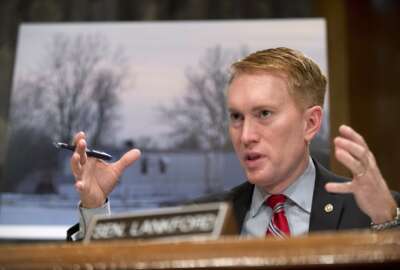Hubbard Radio Washington DC, LLC. All rights reserved. This website is not intended for users located within the European Economic Area.
Enough with all the hiring authorities already, CHCOs tell Congress
Chief human capital officers at two of the largest federal agencies had a clear message for Congress: Don't give us any more hiring authorities.
Best listening experience is on Chrome, Firefox or Safari. Subscribe to Federal Drive’s daily audio interviews on Apple Podcasts or PodcastOne.
When federal hiring authorities come in more then 100 different flavors, it’s no wonder agencies — after sampling several options with a small spoon — stick with the two or three varieties they know best.
Sen. James Lankford (R-Okla.) knows this scenario well, surprisingly from his days scooping ice cream at a Baskin-Robbins as a teenager.
“I distinctly remember when people walked in — with 31 flavors — it took forever to pick one. By default people went to vanilla,” he said Tuesday during a hearing before the Senate Homeland Security and Governmental Affairs Subcommittee on Regulatory Affairs and Federal Management, which he leads. “[That was] the most popular flavor, with 31 options.”
Agencies have at least 105 separate hiring authorities, according to the Government Accountability Office’s last tally back in 2016. The count is likely higher at this point, as agencies have received additional authorities to fill critical skills gaps in cybersecurity and STEM.
Agencies used just 20 of those 105 authorities to fill 90% of open positions in 2014, GAO said.
It’s no wonder agencies spend, on average, 106 days to hire new talent, Lankford said.
But agency chief human capital officers aren’t necessarily satisfied with the status quo.
“Please don’t give us any more hiring authorities,” Angela Bailey, chief human capital officer at the Department of Homeland Security, told Lankford. “We just don’t need any more.”
“You don’t need a double-chocolate, raspberry variation?” Lankford said.
“No. You can put sea salt on top of it, and I still don’t need it,” Bailey said.
Just a handful of hiring authorities might get the job done, she added.
Agencies today, for example, have several authorities to hire veterans. In 2018, 6% of federal job applicants were veterans, yet veterans made up nearly 50% of all new hires that year, according to the Senior Executives Association.
For Bailey, DHS and other agencies really only need one authority to hire veterans, she said.
“[We need] one noncompetitive hiring authority where we can walk into any military transition center, any university [or] any place where you would find a veteran and we would have the opportunity to make them a job offer,” Bailey said. “That would be extremely helpful for us. It would be helpful for the veterans as well, because they would’t have to worry about what their percentage was, or what their rating was or whether they had a campaign badge or not. It would be beneficial for everyone.”
As long as veterans continue to make up a certain percentage of their workforces, agencies should be able to focus on strategically targeting and hiring a diverse group of employees, she added.
Veterans currently make up about one-third of the federal workforce today.
“We should be able to go out within any source to recruit military spouses, students, people with disabilities, [people] with technical skills,” Bailey said. “We need the ability to actually hire people. There is no corporation in the world that has 102 different ways to hire somebody, so it’s no wonder that we, obviously, default to the few that are on the books. It’s not because they’re our favorites. It’s just because it’s probably the go-to thing for us.”
The complex hiring process has forced some agencies like DHS to get creative when filling key positions and mission-critical vacancies. The department rearranged and cut some steps of the hiring process altogether for Border Patrol agents and Customs and Border Protection officers, Bailey said.
DHS, for example, moved the eye and hearing examination up earlier in the hiring process for CBP applicants, Bailey told reporters after Tuesday’s hearing. Applicants who fail the exam can either move on or see an eye doctor more quickly.
The department also created a “fast lane” for CBP applicants who score well on an initial security check. In addition, DHS rearranged some of the questions on its polygraph examination, and Bailey said more applicants are passing.
These changes to the hiring process have cut CBP’s overall time to hire by more than 30%, Bailey said.
In addition, the department’s new cybersecurity personnel system is nearly ready for primetime after several years of preparation. The new personnel system, which should allow DHS to easily recruit, hire and pay its employees, should be available by spring 2020, Bailey said. The system, called Title 6, is a complete departure from the General Schedule.
A moratorium on new hiring authorities?
Like DHS, the Department of Veterans Affairs has experienced its own hiring and retention challenges.
Congress in recent years has given VA a wide variety of hiring authorities. It’s using them, as well as recruitment and retention incentives to attract more clinical talent, said Daniel Sitterly, the department’s assistant secretary for human resources and administration. The department is targeting historically black universities (HBUs) and other colleges to recruit more interns, he added.
But VA also has several pay and personnel systems, which all make life difficult and complex for its HR specialists.
“We simply cannot continue to have the complexities in the pay and personnel system that we have,” he said. “Every time we add a new one, I feel like an HR specialist needs to graduate from law school in order to implement it. Connecting Title 5 changes, with Title 38 changes, with Title 10 changes [mean] there’s always some disconnect.”
That disconnect has led VA to improperly pay more than 600 podiatrists at the department, Sitterly said, due to a complex legal move that transferred the positions from Title 38-Hybrid to Title 38.
“We’re fixing it, but we’ve lost trust and confidence for some very critical people,” he said.
In the meantime, Sitterly suggested Congress should impose a moratorium on the addition of new hiring authorities.
This isn’t the first Lankford has heard about the challenges agencies face with the existing hiring process. He held several “fact-finding” hearings over the last two years on federal management issues.
Lankford, however, is slightly concerned by some of the political implications that could come up if Congress attempted to eliminate any or most existing hiring authorities. Past and present lawmakers likely pushed for specific hiring authorities for a particular group of people for a reason, he said.
“That’s my problem, I have to deal with that,” Lankford said. “Your challenge is that everyone’s also going to look at you and say, ‘does everyone have a competitive shot? Are certain groups going to get more of an opportunity to get in?'”
For Bailey, fewer separate hiring authorities shouldn’t necessarily translate to an unfair advantage, especially if organizations must report hiring statistics to the public. She argued agencies will attract and recruit a workforce with greater diversity if leaders can specifically target it.
“The problem is that we have all these hiring authorities, we have this incredibly complicated system and we’re not that diverse anyhow,” she said. “We ought to try something new and just see if it’s going to work.”
It’s unclear if Congress will, in fact, try something new. Lankford, at least, expressed some sense of urgency.
“We have to move from staring at and marveling at the problem to actually solving the problem. This committee has talked the problem to death,” he said. “Our concern is that everyone’s interest is being fulfilled except for the applicant’s and except for the agency’s.”
Copyright © 2024 Federal News Network. All rights reserved. This website is not intended for users located within the European Economic Area.
Nicole Ogrysko
Nicole Ogrysko is a reporter for Federal News Network focusing on the federal workforce and federal pay and benefits.
Follow @nogryskoWFED
Related Stories
Related Stories
-
Agencies may have too many special hiring authorities, OPM admits Hiring/Retention




